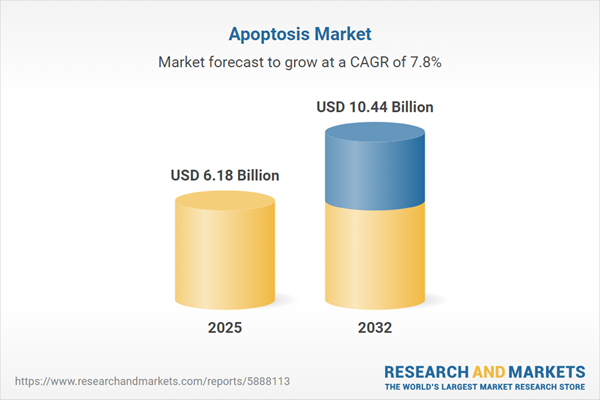Speak directly to the analyst to clarify any post sales queries you may have.
The Apoptosis Market is evolving rapidly, offering new opportunities for organizations navigating the dynamic life sciences ecosystem. This report provides actionable analysis to help senior decision-makers capitalize on current and emerging trends within apoptosis research and its commercial landscape.
Market Snapshot: Apoptosis Market Growth and Opportunity
The Apoptosis Market grew from USD 5.72 billion in 2024 to USD 6.18 billion in 2025. It is expected to continue expanding at a CAGR of 7.79%, reaching USD 10.44 billion by 2032. This significant momentum is driven by advancements in cellular biology, the adoption of multi-omics platforms, and the increasing need for innovative diagnostic and therapeutic solutions in both research and clinical settings.
Scope & Segmentation: Broad Market Coverage Across Applications and Geographies
- Product Type: Instruments (including flow cytometers, microscopes, plate readers), kits (detection and staining kits), reagents (antibodies, assays, buffers).
- Technology: Elisa, flow cytometry, PCR, western blotting.
- Application: Basic research, clinical diagnostics, drug discovery.
- End User: Academic institutes, biotechnology companies, contract research organizations, pharmaceutical companies.
- Geographic Regions: Americas (North America subregions: United States, Canada, Mexico; Latin America subregions: Brazil, Argentina, Chile, Colombia, Peru), Europe, Middle East & Africa (countries such as the United Kingdom, Germany, France, Russia, Italy, Spain, Netherlands, Sweden, Poland, Switzerland, United Arab Emirates, Saudi Arabia, Qatar, Turkey, Israel, South Africa, Nigeria, Egypt, Kenya), Asia-Pacific (including China, India, Japan, Australia, South Korea, Indonesia, Thailand, Malaysia, Singapore, Taiwan).
- Leading Companies: Thermo Fisher Scientific Inc., Merck KGaA, Danaher Corporation, Bio-Rad Laboratories, Inc., Bio-Techne Corporation, PerkinElmer, Inc., Abcam plc, Becton, Dickinson and Company, Promega Corporation, Cell Signaling Technology, Inc.
Key Takeaways: Strategic Insights into the Apoptosis Market
- Integration of artificial intelligence and machine learning is redefining apoptosis research, enhancing data analysis and supporting the discovery of novel biomarkers.
- Advanced assay kits and high-resolution platforms continue to empower pharmaceutical and biotechnology firms, translating scientific insights into targeted therapeutics and efficient drug screening.
- Collaborative consortia and data-sharing initiatives are improving transparency, reproducibility, and streamlining the transition from research to clinical application.
- Supply chain diversification and investment in regional manufacturing are strengthening resilience amid global challenges and regulatory shifts.
- The market rewards organizations that prioritize standardization and cross-laboratory validations, ensuring regulatory acceptance and reliable results across the ecosystem.
- Cutting-edge advancements in microfluidics and imaging technologies support high-content, single-cell analysis, driving innovation in both product offerings and research outcomes.
Tariff Impact: Navigating Policy-Driven Supply Chain Shifts
Recent United States tariff policies have affected the import and procurement of specialized apoptosis research instruments and reagents, leading to longer lead times and increased costs for research institutions. As a strategic adaptation, stakeholders are exploring alternative regional partnerships, investing in local assembly, and adopting multiplexed solutions to optimize efficiency and mitigate procurement challenges. These shifts are accelerating the diversification and resilience of global supply chains, enabling organizations to maintain progress amid regulatory and logistical uncertainties.
Methodology & Data Sources: Rigorous Foundation for Market Insights
The findings in this report are grounded in a robust research methodology combining primary interviews with industry experts, consultations with procurement and R&D leaders, and validation workshops with subject matter specialists. Secondary data coverage includes peer-reviewed literature, patents, conference outputs, and regulatory guidance on apoptosis assays and instrumentation. Triangulation across data streams ensures balanced, credible, and actionable insights.
Why This Report Matters: Optimize Strategy in Apoptosis Research
- Identify actionable growth opportunities and mitigate market risks through a comprehensive, segmented analysis of instruments, reagents, technologies, and applications.
- Support executive decisions on investments and partnerships by leveraging detailed, region-specific insights and profiles of leading industry players.
- Strengthen operational resilience and future-proof research capabilities by understanding the impact of global supply chain developments and regulatory trends.
Conclusion
This report equips decision-makers with critical insights to navigate the evolving apoptosis market, capitalize on emerging trends, and align organizational strategy with shifting industry dynamics. Adopting the outlined best practices will position stakeholders for long-term success in this dynamic field.
Additional Product Information:
- Purchase of this report includes 1 year online access with quarterly updates.
- This report can be updated on request. Please contact our Customer Experience team using the Ask a Question widget on our website.
Table of Contents
3. Executive Summary
4. Market Overview
7. Cumulative Impact of Artificial Intelligence 2025
Companies Mentioned
The companies profiled in this Apoptosis market report include:- Thermo Fisher Scientific Inc.
- Merck KGaA
- Danaher Corporation
- Bio-Rad Laboratories, Inc.
- Bio-Techne Corporation
- PerkinElmer, Inc.
- Abcam plc
- Becton, Dickinson and Company
- Promega Corporation
- Cell Signaling Technology, Inc.
Table Information
| Report Attribute | Details |
|---|---|
| No. of Pages | 194 |
| Published | October 2025 |
| Forecast Period | 2025 - 2032 |
| Estimated Market Value ( USD | $ 6.18 Billion |
| Forecasted Market Value ( USD | $ 10.44 Billion |
| Compound Annual Growth Rate | 7.7% |
| Regions Covered | Global |
| No. of Companies Mentioned | 11 |









